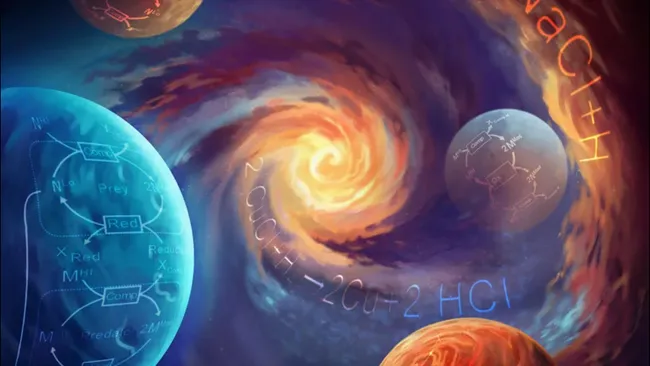Extraterrestrial existence could potentially develop from elements vastly different from those that shaped human life.
Radioactive metals and even certain gases may be capable of the kinds of reactions needed to spur life, new research suggests.
A recent study has discovered that self-sustaining chemical reactions capable of supporting a completely different form of biology from what we know on Earth could potentially exist on various planets. These reactions would utilize elements other than carbon, which is the foundation of life on our planet. On Earth, life is primarily based on organic compounds that consist of carbon along with other elements like hydrogen, oxygen, nitrogen, phosphorus, and sulfur. However, scientists have always been curious about the possibility of life evolving based on entirely different chemistry. Silicon, for instance, has been proposed as a potential alternative to carbon as the fundamental building block of alien biology. According to Betül Kaçar, a senior author of the study and an astrobiologist, bacteriologist, and evolutionary biologist at the University of Wisconsin-Madison, it is crucial to explore these possibilities in order to broaden our understanding of the various forms life can take, not just limited to Earth’s life.
Autocatalysis, a crucial chemical interaction for life on Earth, plays a significant role in the reproduction process. This self-sustaining reaction produces molecules that facilitate the repetition of the same reaction. Consider the analogy of a growing population of rabbits. When pairs of rabbits come together, they give birth to new rabbits, who then grow up, pair off, and produce even more rabbits. With just a few rabbits, the population can quickly multiply.
The concept of autocatalysis is of great interest to researchers studying the origin of life because reproduction, a fundamental characteristic of life, is an example of autocatalysis. Life catalyzes the creation of more life, as one cell gives rise to two cells, which can then become four, and so on. As the number of cells multiplies, the potential for diverse interactions also increases.
In a recent study, scientists sought to identify autocatalysis beyond organic compounds. They hypothesized that autocatalysis could have played a role in abiogenesis, the emergence of life from non-living matter.
The researchers focused on comproportionation cycles, which can generate multiple copies of a molecule. These products can serve as starting materials to initiate these cycles again, resulting in autocatalysis. Comproportionation is particularly intriguing because it resembles reproduction, as it is a single reaction that produces multiple outputs.

To identify these reactions, the scientists analyzed digitized scientific documents spanning over two centuries and written in various languages. By utilizing effective language search and translation tools, they conducted a groundbreaking assessment of the prevalence of autocatalytic cycles.
Overall, this study sheds light on the potential role of autocatalysis in the origin of life and expands our understanding of the mechanisms that drive the emergence and proliferation of life forms.
In the end, the scientists uncovered 270 distinct autocatalytic reaction cycles. According to Kaçar, “Autocatalysis may not be as uncommon as previously thought, but rather a widespread phenomenon in various environments, even those vastly different from Earth.”
A majority of these cycles did not involve organic compounds. Some revolved around elements that are either absent or extremely rare in Earth’s life, such as mercury or the radioactive metal thorium. Several cycles likely occur only under extreme temperatures or pressures.
Interestingly, the researchers also identified four autocatalytic cycles that involved noble gases, which rarely, if ever, chemically react with other elements. If even an inert gas like xenon can participate in autocatalysis, Peng suggests that it is highly likely that autocatalysis occurs more readily in other elements.
Out of the 270 cycles, only eight were relatively complex, consisting of four or more reactions. The majority of the cycles were simple, comprising just two reactions.
Kaçar stated, “It was previously believed that these types of reactions were very uncommon. We are demonstrating that they are actually quite common, provided you search in the right places.”
The researchers also noted that it is possible to combine multiple cycles, even if they are vastly different from one another. This could result in self-sustaining chemical reactions that generate a wide range of molecules, leading to increased complexity.
“With numerous fundamental autocatalysis recipes at our disposal, the focus of research can now shift towards understanding how autocatalysis, through comproportionation, can significantly influence a planet’s chemistry,” Kaçar explained.
The scientists are hopeful that future research will be able to experimentally test the findings presented in this new cookbook they have compiled.
Peng emphasized that the cycles presented in this study offer a diverse range of basic recipes that have the potential to be combined and experimented with in unprecedented ways. These novel combinations could potentially unveil entirely new examples of complex chemistry that function under conditions where carbon- or silicon-based cycles fail due to combustion or freezing.
However, it is important to note that the plausibility of these cycles is still uncertain, as cautioned by the researchers. Not all of the compiled examples may be feasible to replicate in a laboratory setting or be observed on other celestial bodies.
Furthermore, aside from the profound implications this research holds for the quest to discover life beyond Earth and comprehend the origins of life itself, there are practical applications to consider. Adam highlighted the potential for optimizing chemical synthesis and maximizing resource and energy efficiency. Additionally, these chemical compounds could be utilized for intriguing tasks such as chemical computation.
The scientists published their detailed findings on September 18 in the Journal of the American Chemical Society.
This article is republished from livescience under a Creative Commons license. Read the original article.
Do not forget to share your opinion with us to provide you with the best posts !




0 Comments